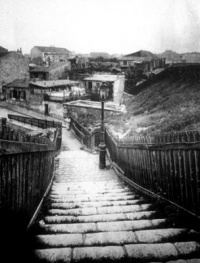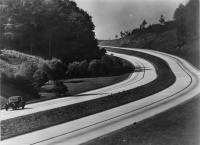20th century
From The Art and Popular Culture Encyclopedia

(Photo by Walery)

|
Related e |
|
Featured: |
- 1900s, 1910s, 1920s, 1930s, 1940s, 1950s, 1960s, 1970s, 1980s, 1990s
- 20th century art, 20th century literature, 20th century erotica, 20th century culture, 20th century music
The 20th century of the Anno Domini began on January 1, 1901 and ended on December 31, 2000.
The British, Chinese, Russian, German, Ottoman, and Austro-Hungarian empires dissolved in the first half of the century, with all but the British, French, and Japanese empires collapsing during the course of World War I, and Russia transformed into communist state of Soviet Union. The inter-war years saw a Great Depression cause a massive disruption to the world economy. Shortly afterwards, World War II broke out, pitting the Allied powers (chiefly the United States, the United Kingdom and the Soviet Union) against the Axis powers (Nazi Germany, the Empire of Japan, and Italy) which eventually resulted in a total victory for the Allies, at the cost of over 60 million lives and the complete devastation of many nations. Remaining colonial empires dissolved shortly after the war. As a means of preventing future world wars, the United Nations was formed; however, competition between the two new superpowers, the Soviet Union and the United States, resulted in the Cold War, which would dominate geopolitical life for the next 45 years. The Soviet Union collapsed internally in 1991, resulting in the United States taking on sole superpower status.
The century saw a major shift in the way that vast numbers of people lived, as a result of changes in politics, ideology, economics, society, culture, science, technology, and medicine. Terms like ideology, world war, genocide, and nuclear war entered common usage. Scientific discoveries, such as the theory of relativity and quantum physics, drastically changed the worldview of scientists, causing them to realize that the universe was fantastically more complex than previously believed, and dashing the hopes at the end of the 19th century that the last few details of scientific knowledge were about to be filled in. Accelerating scientific understanding, more efficient communications, and faster transportation transformed the world in those hundred years more rapidly and widely than in any previous century. It was a century that started with horses, simple automobiles, and freighters but ended with luxury sedans, cruise ships, airliners and the space shuttle. Horses, Western society's basic form of personal transportation for thousands of years, were replaced by automobiles and buses within the span of a few decades. These developments were made possible by the large-scale exploitation of fossil fuel resources (especially petroleum), which offered large amounts of energy in an easily portable form, but also caused widespread concerns about pollution and long-term impact on the environment. Humans explored outer space for the first time, even taking their first footsteps on the Moon.
Mass media, telecommunications, and information technology (especially computers, paperback books, public education, and the Internet) made the world's knowledge more widely available to people. Many people's view of the world changed significantly as they became much more aware of the struggles of others and, as such, became increasingly concerned with human rights.Template:Citation needed Advancements in medical technology also improved the welfare of many people: the life expectancy of the world increased from 35 years to 65 years. Rapid technological advancements, however, also allowed warfare to reach unprecedented levels of destruction. World War II alone killed over 60 million people, while nuclear weapons gave humankind the means to annihilate or significantly harm itself in a very short period of time. The world also became more culturally homogenized than ever with developments in transportation and communications technology, popular music and other influences of Western culture, international corporations, and what was arguably a true global economy by the end of the century.
Trends
- Rising nationalism caused World War I, the Great Depression, fascism and nazism, and subsequently World War II, the German genocide and the atomic bombings of Hiroshima and Nagasaki.
- As the century begins, Paris is the artistic capital of the world, where both French and foreign writers, composers and visual artists gather. By the end of the century, the focal point of culture had moved to the United States, especially New York City and Los Angeles.
- Movies, music and the media had a major influence on fashion and trends in all aspects of life. As many movies and music originate from the United States, American culture spread rapidly over the world.
- After gaining political rights in the United States and much of Europe in the first part of the century, and with the advent of new birth control techniques women became more independent throughout the century.
- In classical music, composition branched out into many completely new domains, including dodecaphony, aleatoric and chance music, and minimalism. Electronic musical instruments were developed as well, vastly broadening the scope of sounds available to composers and performers.
- Rock and Roll and Jazz styles of music are developed in the United States, and quickly become the dominant forms of popular music in America, and later, the world.
- The plastic arts developed new styles such as expressionism, cubism, and surrealism.
- Modern architecture evolved within Europe with a radical departure from the excess decoration of the Victorian era — streamlined forms inspired by machines became more commonplace. Developments in building material technologies furthered this shift. European architects moved to the United States prior to World War II, where modern archiectural theory continued to blossom.
- The automobile provided vastly increased transportation capabilities for the average member of Western societies in the early to mid-century, spreading even further later on. City design throughout most of the West became focused on transport via car. The car became a leading symbol of modern society, with styles of car suited to and symbolic of particular lifestyles.
- Sports became an important part of society, becoming an activity not only for the privileged. Watching sports, later also on television, became a popular activity.
Years
- 2000 - 1999 - 1998 - 1997 - 1996 - 1995 - 1994 - 1993 - 1992 - 1991
- 1990 - 1989 - 1988 - 1987 - 1986 - 1985 - 1984 - 1983 - 1982 - 1981
- 1980 - 1979 - 1978 - 1977 - 1976 - 1975 - 1974 - 1973 - 1972 - 1971
- 1970 - 1969 - 1968 - 1967 - 1966 - 1965 - 1964 - 1963 - 1962 - 1961
- 1960 - 1959 - 1958 - 1957 - 1956 - 1955 - 1954 - 1953 - 1952 - 1951
- 1950 - 1949 - 1948 - 1947 - 1946 - 1945 - 1944 - 1943 - 1942 - 1941
- 1940 - 1939 - 1938 - 1937 - 1936 - 1935 - 1934 - 1933 - 1932 - 1931
- 1930 - 1929 - 1928 - 1927 - 1926 - 1925 - 1924 - 1923 - 1922 - 1921
- 1920 - 1919 - 1918 - 1917 - 1916 - 1915 - 1914 - 1913 - 1912 - 1911
- 1910 - 1909 - 1908 - 1907 - 1906 - 1905 - 1904 - 1903 - 1902 - 1901
See also
- History of subcultures in the 20th century
- 20th century art
- 20th century erotica
- 20th century culture
- Lipstick Traces: A Secret History of the 20th Century
- Straight to Hell: 20th Century Suicides
- 20th century philosophy
- French literature of the 20th century
- TIME Magazine's 100 most influential people of the 20th century
- French art of the 20th century
- Literature of the 20th century
- Primitivism in 20th Century Art
- 20th century in literature
- The Century of the Self





